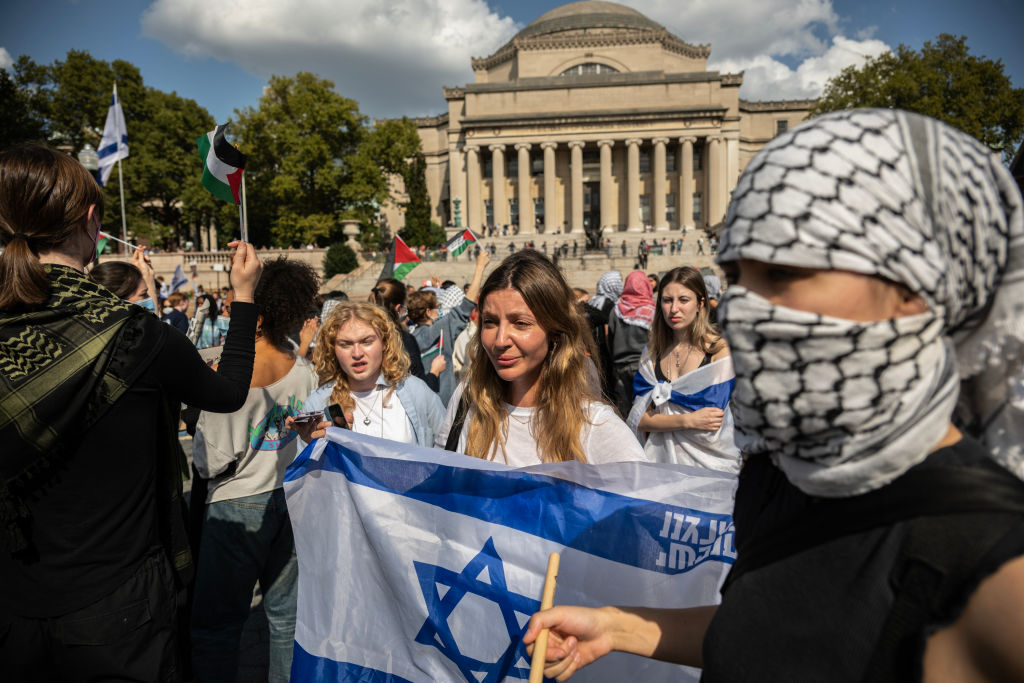Columbia University, New York
“Bring them home,” went the chants of pro-Israeli students on the Columbia University campus yesterday, marking the anniversary of the 7 October attack and the subsequent war in Gaza. Over those chants, cries of “Long live the intifada” could be heard from far beyond the campus walls.
Over the last year, Columbia’s campus has become a focal point for the growing tension around the conflict, and regularly sees spillover consequences from flare-ups on the ground in the Middle East. Yesterday, hundreds of students gathered for protests, vigils, and counter-protests, with a heavy private security presence policing the central quad which last year was home to the main pro-Palestine encampment. NYPD officers in riot gear lined the iron-clad gates outside on Broadway and 116th Street.
On one side of the plaza, the pro-Palestine group Columbia University Apartheid Divest (CUAD) led a large demonstration, demanding the college divest from companies profiting off Israeli military operations in Gaza. On the other side, members of Students Supporting Israel (SSI) organised a counter-protest, accusing CUAD of aligning with Hamas and fostering an environment hostile to Jewish students. What began as two opposing gatherings soon evolved into a cacophony of chants and slogans that reverberated across campus: “From the river to the sea, Palestine will be free,” clashed with “Am Yisrael Chai” (“The people of Israel live”).
The CUAD protesters carried placards featuring images of children and families from Gaza, while some held up a copy of the “The New York Crimes” — a leaflet take on The New York Times, accusing mainstream outlets of failing to cover the reality of the war. They demanded divestment from companies such as Lockheed Martin, Amazon, and Google, which they claim are profiting from the violence in the region.
On the other side of the quad, Israeli flags fluttered above a vocal gathering of Jewish students, who had set up a milk-carton style art exhibit to memorialise victims who attended last year’s Nova Music Festival. Eliana Goldin, co-chair of Jewish student group Arye, said the exhibit was meant to reflect on the pain of the Jewish community. “We just want people to understand where we’re coming from and what the Jewish and Israeli experience has been like this past year,” she explained. “There are a lot of terrible images we could have put up […] but we didn’t want to scar anyone for life.”
As the two groups staged their events, tensions simmered. Shai Davidai, an assistant professor at Columbia and a controversial figure in the Jewish protests known for verbally attacking students on the other side, urged his supporters not to engage with the opposition. “This day is not about them,” he said in a mix of Hebrew and English. “This day is about us […] We are still here, and we are not going anywhere.” Roughly 100 supporters stood by, many waving Israeli flags or holding posters of those kidnapped by Hamas.
Across the plaza, a sea of keffiyeh-clad students pushed back. As the CUAD demonstration gained momentum, protestors chanted louder: “Intifada, revolution!” and “Zionists not welcome here.” Their gathering was just the latest in a series of protests that have become a fixture of Columbia’s academic year. The visual contrast of the two groups — one in mourning, the other in defiance — was stark.
CUAD’s walkout culminated in a march through campus before joining the wider protest organised by Within our Lifetime (WOL) in New York City, while the Jewish students remained in place, reflecting on the year that had passed since the Hamas attacks.
The evening prior, on 6 October, the university campus was nearly locked down at short notice. Access to all buildings bar one library and student dormitories was deactivated. Throughout the week leading up to the anniversary, CUAD had been holding a vigil during which the names of the 40,000 Palestinians killed in Gaza were read aloud. Over the course of several days students took turns reciting names, as a memorial garden of Palestinian flags and photographs of the dead sprang up on the grass beside the quad. “All our martyrs have a name,” read one of the posters.
Columbia’s administration has remained tight-lipped, attempting to toe the line while receiving criticism from both groups. Meanwhile, interim president Katrina Armstrong has contemplated committing Columbia to institutional neutrality in the wake of the resignation of her predecessor Minouche Shafik. The barricades around Alma Mater — a symbol of Columbia — have now become emblematic of the divisions that now define the university.
Yet for all the vocal activism, many students continued with their routines, walking past the protests without stopping. For others, the tensions on campus feel like a microcosm of a broader global divide. As Columbia remains a flashpoint in the battle over free speech and Middle East politics, the university is bracing for what promises to be a year of continued unrest.











Join the discussion
Join like minded readers that support our journalism by becoming a paid subscriber
To join the discussion in the comments, become a paid subscriber.
Join like minded readers that support our journalism, read unlimited articles and enjoy other subscriber-only benefits.
Subscribe